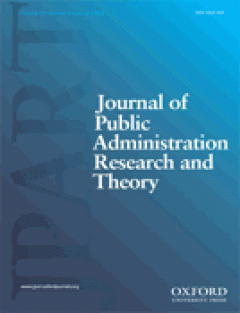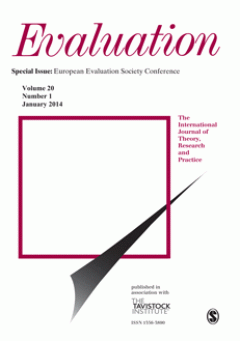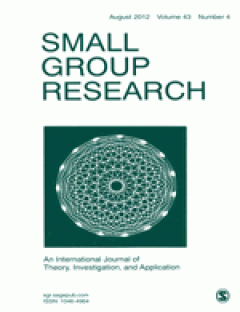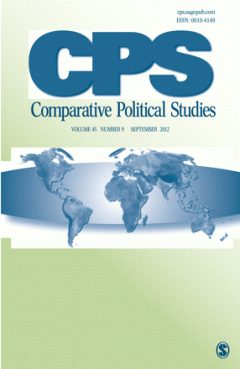Filter by

Policy Divergence in Implementation: How Conflict among Decisive Legislators …
The question whether political conflict affects the course and outcomes of policy implementation is debated among scholars in public administration. Whereas some scholars emphasize the mediating effects of procedures for political control of bureaucracy, other scholars highlight the actions and preferences of agencies. The present study combines both perspectives and argues that policy divergen…
- Edition
- Volume 22 Issue 2 April 2012 p. 195-217
- ISBN/ISSN
- 1053-1858
- Collation
- p. 195-217
- Series Title
- Journal of Public Administration Research & Theory
- Call Number
- -

The Consequences of Presidential Patronage for Federal Agency Performance
In this article, we examine the relationship between presidential patronage and federal agency performance. Using Program Assessment Rating Tool (PART) management scores for 1,016 federal programs during the Bush Administration, we compare the performance of federal programs administered by appointees from the campaign or party against programs run by other appointees or career professionals. W…
- Edition
- Volume 22 Issue 2 April 2012 p. 219-243
- ISBN/ISSN
- 1053-1858
- Collation
- p. 219-243
- Series Title
- Journal of Public Administration Research & Theory
- Call Number
- -

Evidence-Based Practice and the Use of Information in State Agency Decision M…
The contemporary policy environment makes persistent demands on agency officials to use the best information available when making decisions about policies, programs, and practices. State and federal legislation calls on agencies to incorporate evidence-based practices (EBP) in their programs. Using data from a 2008 survey of state agency directors, we examine the extent to which state governme…
- Edition
- Volume 22 Issue 2 April 2012 p. 245-266
- ISBN/ISSN
- 1053-1858
- Collation
- p. 245-266
- Series Title
- Journal of Public Administration Research & Theory
- Call Number
- -

Public Participation and Organizational Performance: Evidence from State Agen…
Public participation in administrative decision making has been widely advocated by both theorists and practitioners of public administration. Despite the importance of citizen engagement, we know little about its impact on the performance of government agencies. Is participation only normatively desirable or does it have some practical value attached to it? We draw on data from U.S. state tran…
- Edition
- Volume 22 Issue 2 April 2012 p. 267-288
- ISBN/ISSN
- 1053-1858
- Collation
- p. 267-288
- Series Title
- Journal of Public Administration Research & Theory
- Call Number
- -

Contracting or Public Delivery? The Importance of Service, Market, and Manage…
Analysis of local government contracting decisions typically focuses on transactions costs related to service characteristics, especially asset specificity and difficulty of contract management. This analysis expands the focus to include market characteristics (competition), citizen characteristics (public interest in the service delivery process), and place characteristics (metro status and pu…
- Edition
- Volume 22 Issue 2 April 2012 p. 289-317
- ISBN/ISSN
- 1053-1858
- Collation
- p. 289-317
- Series Title
- Journal of Public Administration Research & Theory
- Call Number
- -

Treating Policy Brokers Seriously: Evidence from the Climate Policy
The advocacy coalition framework (ACF) pays special attention to “so-called” policy brokers when explaining policy change. However, this prominent policy approach neither clearly defines who the policy brokers are nor identifies under which institutional rules they have an influence on policy processes and outputs. This article thus formulates two theoretical hypotheses that complement the ACF …
- Edition
- Volume 22 Issue 2 April 2012 p. 319-346
- ISBN/ISSN
- 1053-1858
- Collation
- p. 319-346
- Series Title
- Journal of Public Administration Research & Theory
- Call Number
- -

The Politics of Ex Parte Lobbying: Pre-Proposal Agenda Building and Blocking …
Scholars generally agree that interest groups are active and at times influential during the notice and comment period of regulatory policymaking (or “rulemaking”). But current research often ignores the agenda setting that may take place during the pre-proposal stage of rulemaking. During proposal development, interest groups may lobby to: (1) influence the content of proposed regulations or (…
- Edition
- Volume 22 Issue 2 April 2012 p. 373-393
- ISBN/ISSN
- 1053-1858
- Collation
- p. 373-393
- Series Title
- Journal of Public Administration Research & Theory
- Call Number
- -

Contribution analysis: Coming of age?
In this introductory article, a brief history and introduction to contribution analysis is provided to lay the stage for the articles that follow. At the heart of contribution analysis is the aim to be able to make credible causal claims about the contribution an intervention is making to observed results. The key role that theories of change play is noted, and what a useful theory of change ou…
- Edition
- Volume 18 Number 3, July 2012 p. 270-280
- ISBN/ISSN
- 1356-3890
- Collation
- p. 270-280
- Series Title
- Evaluation : The International Journal of Theory, research and Practice
- Call Number
- -

Applying contribution analysis: Lessons from five years of practice
Contribution analysis (CA) has been advocated and discussed more than it has been applied. This article draws on five evaluations applying CA in the context of EU policies in the areas of development aid, agriculture, employment, and governance. Over the last five years, the authors have developed their capacity to implement the six steps of CA and especially to draft contribution stories and t…
- Edition
- Volume 18 Number 3, July 2012 p. 281-293
- ISBN/ISSN
- 1356-3890
- Collation
- p. 281-293
- Series Title
- Evaluation : The International Journal of Theory, research and Practice
- Call Number
- -

Making contribution analysis work: A practical framework for handling influen…
This article examines the methodological strengths and weaknesses of contribution analysis. The authors contend that a salient characteristic of contribution analysis is its accounting for influencing factors and alternative explanations. We argue that contribution analysis in its current form needs further methodological and practical elaboration in this respect. Therefore, this article pays p…
- Edition
- Volume 18 Number 3, July 2012 p. 294-309
- ISBN/ISSN
- 1356-3890
- Collation
- p. 294-309
- Series Title
- Evaluation : The International Journal of Theory, research and Practice
- Call Number
- -

Applications of contribution analysis to outcome planning and impact evaluation
Contribution analysis is a structured approach to theory-based impact evaluation originally developed in Canada in the context of Results-Based Management (RBM) although there have been few examples of contribution analysis in practice since Mayne’s original paper (2001). We argue that contribution analysis adds value to other theory-based evaluation approaches by providing a more structured an…
- Edition
- Volume 18 Number 3, July 2012 p. 310-329
- ISBN/ISSN
- 1356-3890
- Collation
- p. 310-329
- Series Title
- Evaluation : The International Journal of Theory, research and Practice
- Call Number
- -

Linking theory-based evaluation and contribution analysis: Three problems and…
Contribution analysis and theory-based evaluation are linked. This article discusses the contributions of several (recent) developments to further deepen the links between theory-based evaluation and contribution analysis. This will be done by describing how three well-known (and almost classical) problematic situations for impact evaluations can be addressed through the application of insights…
- Edition
- Volume 18 Number 3, July 2012 p. 348-363
- ISBN/ISSN
- 1356-3890
- Collation
- p. 348-363
- Series Title
- Evaluation : The International Journal of Theory, research and Practice
- Call Number
- -

A utilization-focused approach to contribution analysis
Utilization-focused evaluation involves identifying and working with primary intended users to design and interpret an evaluation. This includes the process of working with primary intended users to render judgments about the extent to which the preponderance of evidence supports a meaningful and useful conclusion about degree to which an intervention has affected observed outcomes and impacts.…
- Edition
- Volume 18 Number 3, July 2012 p. 364-377
- ISBN/ISSN
- 1356-3890
- Collation
- p. 364-377
- Series Title
- Evaluation : The International Journal of Theory, research and Practice
- Call Number
- -

Towards an evidence base of theory-driven evaluations: Some questions for pro…
This article discusses the further development of theory-driven evaluation approaches that are informed by contribution analysis. Using an illustrative example of an ongoing dance/physical activity programme for health promotion, a number of challenges are identified when applying a theory-driven evaluation approach. These challenges are reformulated as questions that need to be answered to mak…
- Edition
- Volume 18 Number 3, July 2012 p. 378-395
- ISBN/ISSN
- 1356-3890
- Collation
- p. 378-395
- Series Title
- Evaluation : The International Journal of Theory, research and Practice
- Call Number
- -

Does Excluding Some Groups From Research Designs Improve Statistical Power?
This article aims to contribute to a controversy over whether excluding some small or incomplete groups from a sample improves statistical power in group research designs (designs that relate group-level characteristics to group-level outcome measures). In a series of simulation studies, we examined the trade-off between lower reliability and smaller sample size that occurs when very small grou…
- Edition
- Volume 43 Number 4, August 2012 p. 387-409
- ISBN/ISSN
- 1046-4964
- Collation
- p. 387-409
- Series Title
- Small Group Research: An International Journal of Theory, Investigation and Application
- Call Number
- -

Collective Personality Effects on Group Citizenship Behavior: Do Diverse Grou…
This study examines the interaction of collective personality (i.e., the Big Five traits) and national diversity on group interpersonal citizenship behavior. Groups composed of diverse nationalities are theorized to manifest fewer initial shared understandings, enabling them to obtain more benefits than homogeneous groups from collective personality traits that promote better quality relationsh…
- Edition
- Volume 43 Number 4, August 2012 p. 410-442
- ISBN/ISSN
- 1046-4964
- Collation
- p. 410-442
- Series Title
- Small Group Research: An International Journal of Theory, Investigation and Application
- Call Number
- -

Reliability Estimates for Multilevel Designs in Group Research
Items that capture group members’ outcomes from small group processes (e.g., satisfaction, cohesion) are often nonindependent. A primary assumption of most measurement models is that the data are independent; applying such models to group-outcome data measured at the individual level of analysis is thus likely to produce inaccurate estimates. A solution to the measurement of nonindependent data…
- Edition
- Volume 43 Number 4, August 2012 p. 443-467
- ISBN/ISSN
- 1046-4964
- Collation
- p. 443-467
- Series Title
- Small Group Research: An International Journal of Theory, Investigation and Application
- Call Number
- -

Using the Actor–Partner Interdependence Model to Study the Effects of Group…
We extend the actor–partner interdependence model (APIM), a model originally proposed for the analysis of dyadic data, to the study of groups. We call this extended model the group actor–partner interdependence model or GAPIM. For individual outcomes (e.g., satisfaction with the group), we propose a group composition model with four effects; for group-level outcomes (e.g., group productivity), …
- Edition
- Volume 43 Number 4, August 2012 p. 468-496
- ISBN/ISSN
- 1046-4964
- Collation
- p. 468-496
- Series Title
- Small Group Research: An International Journal of Theory, Investigation and Application
- Call Number
- -

Triggers of Students’ Efficacious Interaction in Collaborative Learning Sit…
This article presents a case study that investigated primary school students’ social interaction while working in small groups in science. The aim was to identify what characterizes and triggers students’ efficacious interaction in collaborative learning situations. This was done by exploring and analyzing students’ and groups’ task involvement and the quality of their activity. The micro-level…
- Edition
- Volume 43 Number 4, August 2012 p. 497-522
- ISBN/ISSN
- 1046-4964
- Collation
- p. 497-522
- Series Title
- Small Group Research: An International Journal of Theory, Investigation and Application
- Call Number
- -

Presidents, Parties, and Referenda in Latin America
Over the past two decades the use of referenda has spread throughout Latin America, and 39 referenda have taken place since 1990. For some observers, referenda can improve accountability, promote participation, and reduce corruption. For others, given the strong tradition of Latin American presidentialism, referenda can be manipulated by populist presidents attempting to bypass unpopular repres…
- Edition
- Volume 45 Number 9, September 2012 p. 1159-1187
- ISBN/ISSN
- 1046-4964
- Collation
- p. 1159-1187
- Series Title
- Small Group Research: An International Journal of Theory, Investigation and Application
- Call Number
- -
 Computer Science, Information & General Works
Computer Science, Information & General Works  Philosophy & Psychology
Philosophy & Psychology  Religion
Religion  Social Sciences
Social Sciences  Language
Language  Pure Science
Pure Science  Applied Sciences
Applied Sciences  Art & Recreation
Art & Recreation  Literature
Literature  History & Geography
History & Geography